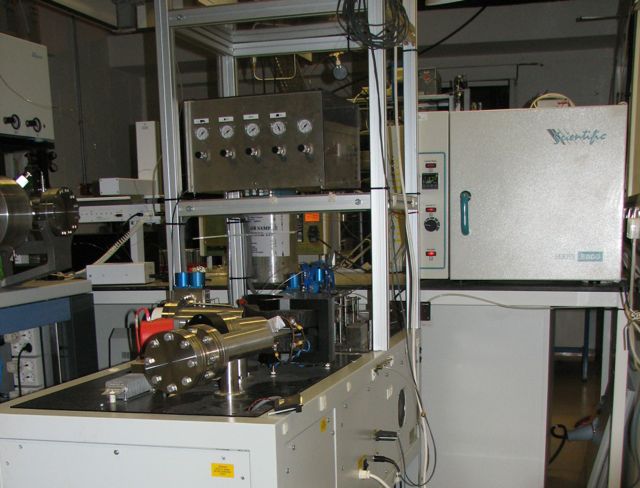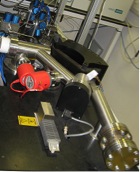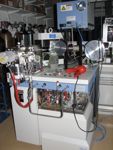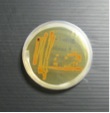
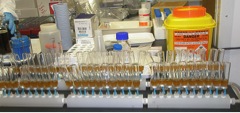
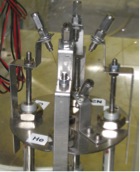
The Analytical Facilities of the School of Environmental Sciences (ENV) offer isotope analysis of nitrate in freshwater and seawater samples for δ(15N), δ(18O) and δ(17O) using the denitrifier method (Sigman et al. (2001), Casciotti et al. 2002, Kaiser et al. 2007). Please send enquiries to Jan Kaiser.
Applications
δ(15N), δ(18O) and δ(17O) can be used to identify sources of nitrate, e.g. chemical fertiliser nitrate, nitrate from rain and nitrate from manure. The isotopic composition of nitrate is also used to study biological processes such as nitrification and denitrification as well as sources of nitrogen oxides (NOx) to the atmosphere and atmospheric reactions leading to gas-phase or particulate nitrate production.Method
We prepare your samples using a bacterial strain that converts nitrate and nitrite in an aqueous sample to nitrous oxide gas. The nitrous oxide in the sample vial is purged from the vial with helium using a double needle, passed through a Nafion drier to remove water, through a sodium hydroxide and magnesium perchlorate scrubber to remove CO2 and further water, a dry ice/ethanol trap (–78 °C) as final drying step, and a trap to remove volatile organic compounds (VOCs). The sample is preconcentrated using liquid nitrogen, passed through a gas chromatograph with a PoraPLOT Q column to separate out any remaining CO2 and VOCs and analysed on a GEO 20-20 isotope ratio mass spectrometer at m/z 44, 45 and 46, from which ratios δ(15N) and δ(18O) values are calculated. For δ(17O) analysis, the nitrous oxide is passed through a gold furnace held at 800 °C to thermally decompose the gas into molecular nitrogen and oxygen, and analysed at m/z 32, 33 and 34 from which δ(17O) and δ(18O) as well as the 17O excess, Δ(17O), are calculated.
Samples are calibrated using the nitrate isotope reference materials IAEA-NO-3, USGS 34 and USGS 35, which are prepared and analysed alongside samples in each batch. Final results are reported relative to Air-N2 for δ(15N)) and VSMOW for δ(18O) and δ(17O) (or VPDB or Air-O2, if desired).
Sample prepraration
Prior to isotope analysis, samples must be filtered and the nitrate and nitrite concentration determined. We recommend that samples are filtered immediately on collection to prevent any biological activity that could affect the isotopic composition of the nitrate. We suggest using cellulose acetate filters with a pore size of 0.2 μm. The most convenient way to filter samples is to use filter units with disposable plastic syringes. We cannot analyse the samples if we do not know the sample concentration beforehand. If required, the ENV Analytical Facilities can also analyse nitrate and nitrite concentrations. Please contact us for a quote.Interferences
The denitrifier method determines the isotopic composition of nitrate plus nitrite and does not discriminate between the two. This means it is necessary to check that the concentration of nitrite in the sample is very small relative to the concentration of nitrate (< 2 %), so that the interference is negligible. For samples with a relatively high proportion of nitrite (> 5 %), we recommend removing nitrite using the method described in Granger and Sigman (2009) before sending samples to us.Analyte amount
We normally need a minimum amount of 20 nmol nitrate for δ(15N) (0.00028 mg N; 0.00124 mg NO3–) and δ(18O) and 50 nmol for δ(17O) (0.00070 mg N; 0.00310 mg NO3–). For lower sample amounts, please contact us.Sample concentration
The minimum nitrate concentration we need to determine δ(15N) and δ(18O) is 2 μmol/L (0.028 mg L–1 N; 0.124 mg L–1 NO3–). If the samples are of a lower concentration, please contact us. For the determination of δ(17O), we require a minimum concentration of 5 μmol/L (0.07 mg L–1 N; 0.31 mg L–1 NO3–). If the samples are of a lower concentration please contact us.Turnaround time
We aim to analyse your samples within 12 weeks.Price
Standard samples: GBP 50 per sample (plus 20 % VAT, if applicable).
| Definition of standard samples | |
| Matrix | Freshwater or seawater |
| Filtration | 0.2 μm cellulose acetate filters |
| Nitrate + nitrite concentrations | Please provide for all samples. |
| Nitrite < 2 % of nitrate concentration | For all samples |
| Minimum nitrate concentration | δ(15N), δ(18O): 2 μmol/l; δ(17O): 5 μmol/l |
| Analyte amount | δ(15N), δ(18O): 20 nmol NO3–; δ(17O): 50 nmol NO3– |
| Minimum number of samples | 30 |
If your samples do not fulfil the above criteria, it may still be possible to analyse them. Non-standard samples will be priced accordingly. Please contact us to discuss your requirements.
Analysis agreement and sample submission
Please contact us before sending us your samples. We will send you a quote, followed by a contract for you to sign. We will then ask you to send us your samples and will send you a sample submission form. Once the samples have been analysed, you will be sent an invoice. Results will be sent after payment of the invoice.
After we request your samples, please send them in clearly labelled plastic bottles or tubes with the lids securely tightened. Complete the sample submission form with unique sample identification numbers (please do not use any special characters (! @ # $ % ^ & * ( ) . / \ +), and the nitrate and nitrite concentrations of the samples. Print the form and enclose it with the samples and also email it to us.
Please contact Jan Kaiser with any questions.
